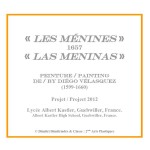Las Meninas ( or Bridesmaids ) (1657) by Diego Velázquez (1599-1660) is “unanimously regarded as one of the miracles of universal painting” [1]. (Cf. Image 1.)
We carried out an analysis of the picture elsewhere, we send back the reader to the following page. (In french)
- 1. Les Ménines, 1657
- 2. Les Ménines, Division du tableau – 1.
- 3. Les Ménines, Division du tableau – 2.
- 4. Les Ménines, Dessin / Drawing
- 5. Les Ménines, Peinture 1 / Painting 1
- 6. Les Ménines, Peinture 2 – 1 / Painting 2 – 1
- 7. Les Ménines, Peinture 2 – 2 / Painting 2 – 2
- 8. Les Ménines, Peinture 2 – 3 / Painting 2 – 3
* * *
1. The declension of the projet
2. Advantages of the project
3. References
* * *
1. The declension of the projet
The declension of the educational project was carried out in several stages :
1. An anlayse and a meticulous observation of the work : organization and composition, the place, the function, the position of the protagonists, the pictures in the picture, the accelerated perspective on the right, the political impact of the work: the painter who had in theory, to paint a portrait of the royal family, it is an another name of the picture “The Family of Philip IV”, he will represent the royal couple, at the background, in a mirror and in a blurred way, and he represents in the foreground a dog. It should not be forgotten that we are in full Spanish Inquisition and they punished for much less than that, but the painter was a forty-year-old friend of the king…
2. Division of the painting. The picture was divided into 36 parts of 30 x 30 cms. The dimensions of the picture are the following : height 318 cms, width 276 cms. The reduction is of a half : 1:2 = > every cm. of the real picture is equal to 0.5 cm of the reproduced picture. What gives, for the height: 30 x 6 = 180 cms. 318/2 = 159 cms. = > + 21 cms, which we added to the left, the invisible inside picture ; for the width, 30 x 5 = 150 cms. 276/2 = 138 cms. = > + 12 cms, that we added on to the lower part of the reproduced picture. We get in the final, a picture of 180 x 150 cms. (Cf. Image 2. et 3.)
3. An important graphic stage on a paper medium in two times: Each student had : 1. To draw a part (Cf. Image 4.) ; 2. To paint his part, by taking account the surrounding colors, those which are next to its own part (Cf. Image 5.) ;
4. A pictorial stage. The student had to reproduce on canvas of 30 x 30 cm. his graphic work. Previously, each student had to prepare his canvas : passing a layer of gesso in a uniform way and to put back his drawing on the canvas. (Cf. Image 6, 7 and 8.)
* * *
2. Advantages of the project
We retain the following advantages:
* The detailed study of an exceptional, single work in the art history, both in its composition and its themes;
* The changes of the supports : from paper to canvas (a fundamental and formal difference) ;
* The Teamwork ;
* The valorization of the student work.
* * *
3. References
* * *








